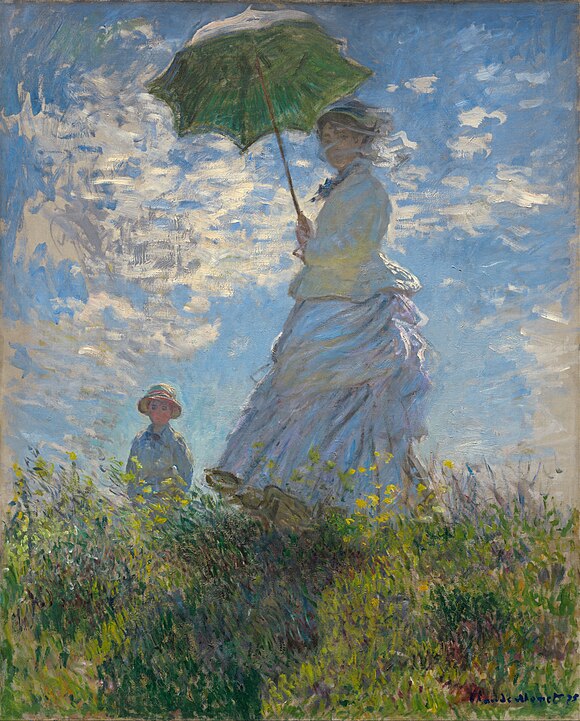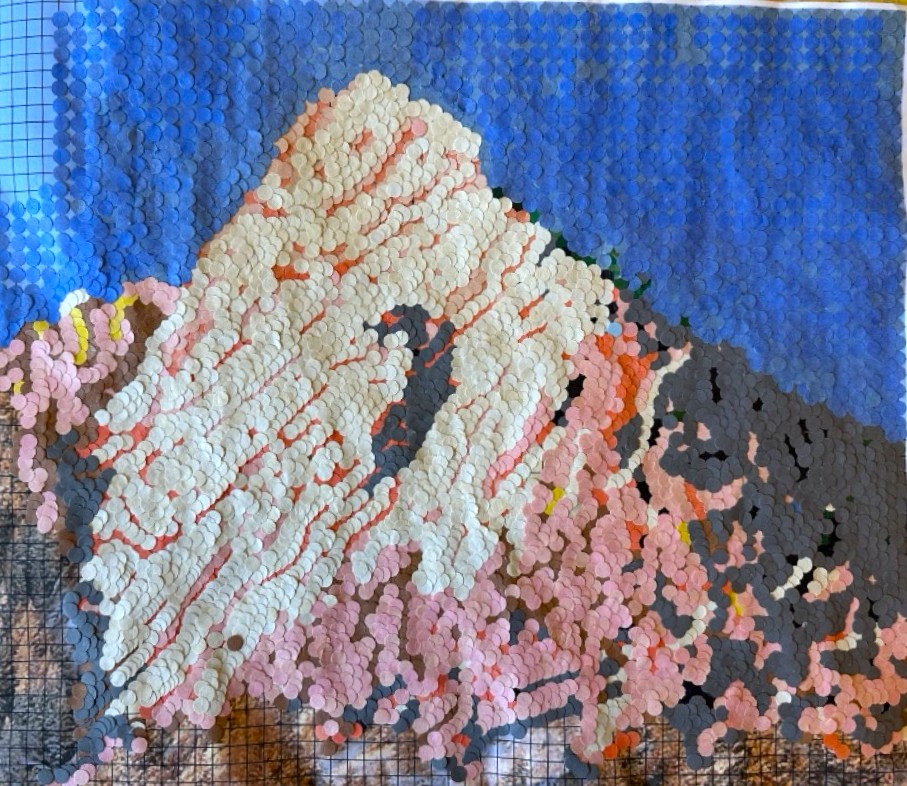Featured Image: Stacks of Wheat (End of Summer) by Claude Monet
For my upcycling project I created a piece called “Flatiron Sunrise” which used the pointillism aesthetic, which was prominent as part of the Neo-Impressionist movement. As the name suggests, the neo-impressionist movement was spawned in reaction to the impressionist movement, and is very much its opposite. “Whereas the Impressionist painters spontaneously recorded nature in terms of the fugitive effects of color and light, the Neo-Impressionists applied scientific optical principles of light and color to create strictly formalized compositions” [1].
Below we can see 2 images, one Impressionist, the other Neo-Impressionist. On the right is Woman with a Parasol – Madame Monet and Her Son, an Impressionist piece by Claude Monet. On the left is Femme à l’ombrelle Neo-impressionist piece by Paul Signac.

 Looking at these pieces side by side, we can see how the two movements contrast each other. Where the neo-impressionists are interested in a scientific representation of light and color, using tiny dots and optical mixing to create the piece, impressionists are concerned with emotion and using brush strokes to create movement and an airy feeling. We can see this especially in the clouds surrounding the woman and her umbrella in Monet’s painting. His brush work is masterful, and his use of white and grey serves to give the entire piece an ethereal feeling, looking up, like how a child may remember a walk with their mother. In contrast, the pointillism piece is unconcerned with brush strokes, placing dots of color precisely to create colors and shapes.
Looking at these pieces side by side, we can see how the two movements contrast each other. Where the neo-impressionists are interested in a scientific representation of light and color, using tiny dots and optical mixing to create the piece, impressionists are concerned with emotion and using brush strokes to create movement and an airy feeling. We can see this especially in the clouds surrounding the woman and her umbrella in Monet’s painting. His brush work is masterful, and his use of white and grey serves to give the entire piece an ethereal feeling, looking up, like how a child may remember a walk with their mother. In contrast, the pointillism piece is unconcerned with brush strokes, placing dots of color precisely to create colors and shapes.
 My piece “Flatiron Sunrise”, shown above, would have been very difficult in the impressionist aesthetic with the materials I was using. Impressionism tends to focus on spontaneity to capture the feeling or impression of a scene whereas the pointillist technique that I was using relies upon pre-planning and trying to scientifically capture the scene. While I think that the composition would be interesting to create as an impressionist piece, my planned use of cardboard dots to create the piece would clash with the ideal of the impressionist movement, where they accentuate the ideals of the neo-impressionist movement.
My piece “Flatiron Sunrise”, shown above, would have been very difficult in the impressionist aesthetic with the materials I was using. Impressionism tends to focus on spontaneity to capture the feeling or impression of a scene whereas the pointillist technique that I was using relies upon pre-planning and trying to scientifically capture the scene. While I think that the composition would be interesting to create as an impressionist piece, my planned use of cardboard dots to create the piece would clash with the ideal of the impressionist movement, where they accentuate the ideals of the neo-impressionist movement.
Sources:
[1] Britannica, The Editors of Encyclopaedia. “Neo-Impressionism”. Encyclopedia Britannica, 14 May. 2024, https://www.britannica.com/art/Neo-Impressionism. Accessed 29 January 2025.
[2] Wikipedia contributors. “Pointillism.” Wikipedia, The Free Encyclopedia. Wikipedia, The Free Encyclopedia, 5 Dec. 2024. Web. 29 Jan. 2025.
[3] Wikipedia contributors. “Impressionism.” Wikipedia, The Free Encyclopedia. Wikipedia, The Free Encyclopedia, 21 Feb. 2025. Web. 4 Mar. 2025Images:
By Claude Monet – https://www.artic.edu/artworks/64818, Public Domain, https://commons.wikimedia.org/w/index.php?curid=80548066
By Claude Monet – EwHxeymQQnprMg — Google Arts & Culture, Public Domain, https://commons.wikimedia.org/w/index.php?curid=22174454
By Paul Signac – Erich Lessing Culture and Fine Arts Archives, Public Domain, https://commons.wikimedia.org/w/index.php?curid=42483307
Flatiron Sunrise – Own Work.


2 Comments. Leave new
I like how you tied your piece to the difference between Impressionism and Neo-Impressionism. The use of cardboard dots really fits with the precise, scientific approach of pointillism. It makes sense that the spontaneous style of Impressionism wouldn’t work with that. Nice way to show the contrast!
Great comparison of the two styles, and “Flatiron Sunrise” is a nice demonstration of for pointillism. Do you think an impressionist version in a different medium would change the feel of the scene?